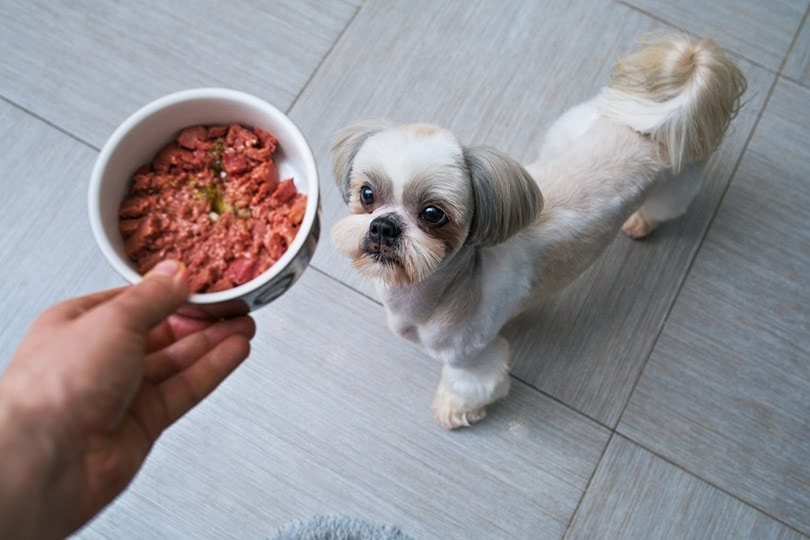Is It Cheaper to Make My Own Dog Food? Important Facts to Consider
Updated on

Click to Skip Ahead
With the recent rise in the cost of pet food, you may have considered making it yourself. There are many factors to consider when making homemade dog food, from the price of ingredients to your pet’s health. Let’s look at what is involved in making your pup’s food from scratch and the risks you should be aware of when making your decision.
Although making your own food is an option for many dog owners and seems to be cheaper, we recommend purchasing a quality, specially formulated one from your favorite retailer since there are a lot of factors to consider for you to give your pup a healthy diet. Commercially available dog foods have undergone inspections and quality control checks to ensure the health and safety of your pet. At the very least, you should discuss your dog’s diet and the possibility of homemade dog food with your pet’s veterinarian for guidance.
Necessary Ingredients
Dogs, at any stage of their lifecycle, need certain ingredients at the core of their diet. All commercially available dog foods include a healthy protein source, usually high-quality meat, as the first ingredient. Most foods provide a mix of vegetables and grains for a balanced nutrient profile. Essential dog food ingredients ensure your dog looks and feels healthy.
- Protein: The protein source is likely beef or poultry but could also be plant-based. Dogs need plenty of protein to support muscle growth and health. More active dogs may need a high-protein diet with additional lean fats.
- Vegetables: From carrots and peas to sweet potatoes and green beans, the right balance of veggies supports overall health. Potassium, calcium, vitamin C, fiber, and many other nutrients are essential to a healthy metabolism, eye and brain health, and immune function.
- Whole Grains: Grains provide long-lasting energy and are a great source of vitamins, minerals, and fiber. Some dogs may benefit from a grain-free diet, but you’ll want to discuss this with their vet before changing their food as they will need alternative sources of nutrition.
Unique Dietary Needs
When making homemade dog food, one critical mistake that many owners make is assuming that their pup’s nutrition is much like their own. However, a dog’s nutritional needs are based mainly on its ancestry 1. They’ve always been hunters and scavengers, adapting to a varied diet. They can process higher amounts of healthy fats and need more protein and carbohydrates to fuel their energy.
There are some foods that your dog should limit or not have. For example, ham is a meat high in protein but typically contains high sodium. Large amounts of ham can cause health issues later on.

Conventionally Grown vs. Organic Foods
When calculating how much it will cost to make homemade dog food, you should consider the ingredients you use. For most foods, you can choose between organic and conventionally farmed. Along with a few benefits of organic foods comes an increased cost that you will need to factor into the overall price of the dog food you make.
In comparison, there are commercially made dog foods that are entirely organic or use organic ingredients that you can feel good about feeding your pup. They offer the same benefits as organic ingredients 2, such as increased nutrients, higher levels of Omega-3 fatty acids, and less pesticide residue.
Dog Food Supplements
Even commercially available dog foods usually include supplements that fortify the ingredients to ensure that dogs receive everything they need from their food. Special formulas may offer supplements unique to their breed or age, such as adult petite or large-breed puppy formulas. Even the most well-curated homemade dog food recipe will most likely lack certain nutritional qualities and need supplements to ensure your pup receives everything they need from their food.
Because a homemade food recipe doesn’t have an ingredient and nutrition label, you and your vet can’t see where their diet is lacking and what should be added. Regular lab testing would be needed to find out where they are deficient so that supplements can be given to correct any imbalances. This can take many visits and a lot of tests to ensure they are physically healthy on a homemade diet. Using pet supplements without the guidance of a veterinarian can be harmful.

Doing the Math
The prices of dog food and grocery store food are constantly changing. To determine if making your own dog food is cheaper, calculate how much you are paying for a mid-range or premium wet and dry dog food per pound. Then, estimate the per-pound cost with all the ingredients you need for a quality recipe that includes supplements recommended by your dog’s vet. Remember to get the recipe you’ve chosen approved by your vet.
You will then need to consider how much your dog eats daily based on size, health, and activity level. Based on your math, how much are you spending per day on commercially available food compared to homemade?
Other costs to consider are the regular vet visits to ensure that your pup gets adequate nutrition from their homemade dog food and the time commitment in making the food. Making dog food can take quite a bit of time, especially if you are feeding many dogs or large dogs.
The Risks of Homemade Dog Food
If based on your math, it’s cheaper for you to make your dog’s food yourself, and you are considering doing so, you should next consider some of the risks.
1. Recipe Quality Control
Commercially available dog foods have plenty of user reviews you can use when making your decision. You know immediately if veterinarians approve the recipe.
2. Ingredient Quality Control
Did you cook the chicken enough? Do you have the same proportion of rice to meat this time as the last? Were the carrots soft enough? Commercial dog food goes through quality control checks throughout the process to ensure it meets the brand’s standards.

3. FDA and USDA Inspections
Even more quality control inspections are done by the FDA and USDA to ensure commercially available dog food is safe for your pet. They inspect the ingredients, the process, the facilities, where the food comes from, and more.
4. Inappropriate Recipes/Substitutions
Did you find that recipe online? How do you know it includes ingredients that are right for your dog and in the correct proportions? Are you tempted to make a change based on what was available at the store? What if someone already did and changed the recipe you found online? There are few guarantees that a homemade dog food recipe is well formulated for your pet.
5. Food Storage Problems
Fresh-made food should be properly refrigerated or frozen. If it’s not appropriately stored, it could make your pup sick. Depending on your available space, storing large amounts of dog food at one time can become difficult.

6. No Turning Back
Dogs may love the taste of homemade food and not want to switch back to dry kibble or even canned wet food. You may be stuck making it for them if they won’t eat commercially available food.
In Summary
Making dog food from scratch is possible, but you should consider not only the cost of the ingredients but the process of making it, the nutritional value of the food, and the cost of the vet visits to ensure that your pet is healthy on the new diet. Even affordable pet foods offer premium nutrition specially formulated for your pet’s breed and life stage.
Featured Image Credit: Cup of Couple, Pexels













